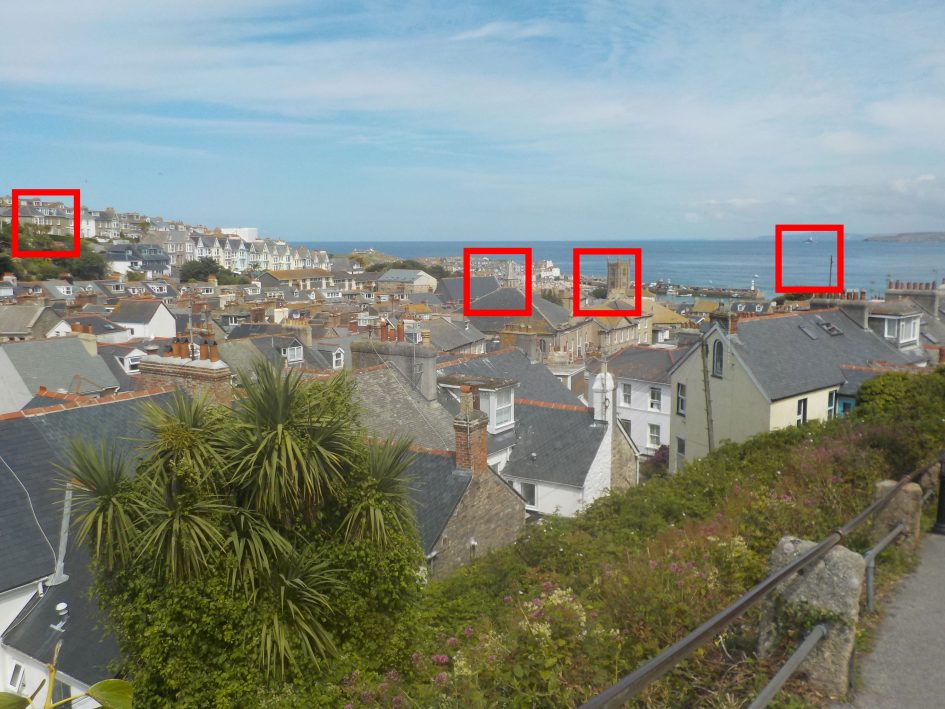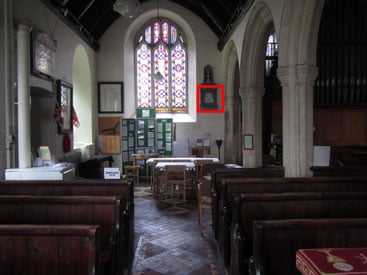Nikon COOLPIX S33 review
-
-
Written by Ken McMahon
Quality
Nikon COOLPIX S33 vs Canon PowerShot D30 vs COOLPIX AW130 quality results
To compare real-life performance, I shot this scene with the Nikon COOLPIX S33, the Canon PowerShot D30 and the Nikon COOLPIX AW130 within a few moments of each other, using their best quality JPEG settings and at their base sensitivity settings. For this test the cameras were mounted on a tripod and image stabilisation was disabled. The cameras were zoomed in to provide the same field of view, the ISO sensitivity was manually set to the lowest available setting and Auto mode was selected for the exposure. On the COOLPIX S33 the ISO sensitivity can’t be set manually and the camera selected 125 ISO. All other settings were left on the defaults.

The COOLPIX S33 gets off to a pretty good start with a crop from the edge of the frame that has plenty of detail and well defined edges. The second crop from closer to the middle is also pretty good – the window frames of the houses in the middle distance are clearly defined, though you can’t see too much detal in the stonework of the tower or the roofs in the bottom part of the crop.
The third crop is also from close to the centre of the frame, but this time there’s a lot less detail and what there is looks a bit clumpy. There’s no detail in the church clock – it looks like a flat disc – and the foreground buildings and harbour in the background are similarly impressionistic. Finally, in the last crop from the right hand edge of the frame the lighthouse sitting on its small island is a little burry and ill-defined.
So a bit of a mixed result from the COOLPIX S33; it looks like the lens is performing well, but the sensor is struggling to resolve the finer detail in the scene. The COOLPIX S33’s 13 Megapixel 1/3.1 inch sensor is physically smaller than the 1/2.3in sensors employed in the other two models. With the same number of photo sites packed into a smaller physical area, you wouldn’t expect the image quality to be quite as good, and it isn’t.
One final thing I should point out is that the Nikon COOLPIX AW130 has a 16 Megapixel sensor which would ordinarily produce crops with a smaller area and bigger detail than the Canon D30, but I slightly under-zoomed the AW130 to 26mm producing a wider field of view which has effectively compensated and produced equivalent sized crops.

Above left: Nikon COOLPIX S33 at 4.1mm (30mm equivalent) f6.6, 125 ISO. Above center: Canon PowerShot D30 at 5.7mm (31mm equivalent) f8, 100 ISO. Above right: Nikon COOLPIX AW130 at 4.7mm (26mm equivalent) f4.1, 125 ISO.

Above left: Nikon COOLPIX S33 at 4.1mm (30mm equivalent) f6.6, 125 ISO. Above center: Canon PowerShot D30 at 5.7mm (31mm equivalent) f8, 100 ISO. Above right: Nikon COOLPIX AW130 at 4.7mm (26mm equivalent) f4.1, 125 ISO.

Above left: Nikon COOLPIX S33 at 4.1mm (30mm equivalent) f6.6, 125 ISO. Above center: Canon PowerShot D30 at 5.7mm (31mm equivalent) f8, 100 ISO. Above right: Nikon COOLPIX AW130 at 4.7mm (26mm equivalent) f4.1, 125 ISO.

Above left: Nikon COOLPIX S33 at 4.1mm (30mm equivalent) f6.6, 125 ISO. Above center: Canon PowerShot D30 at 5.7mm (31mm equivalent) f8, 100 ISO. Above right: Nikon COOLPIX AW130 at 4.7mm (26mm equivalent) f4.1, 125 ISO.
Nikon COOLPIX S33 vs Canon PowerShot D30 vs COOLPIX AW130 noise results
To compare noise levels under real-life conditions, I shot this scene with the Nikon COOLPIX S33, the Canon PowerShot D30 and the Nikon COOLPIX AW130 within a few moments of each other at each of their ISO settings. All three cameras were set to their best quality JPEG modes and mounted on a tripod and stabilisation was disabled.
The cameras were zoomed in to provide the same field of view, the ISO sensitivity was manually set to the lowest available setting and Auto mode was selected for the exposure.
The Nikon COOLPIX S33 doesn’t provide manual selection of the ISO sensitivity and for the test scene selected an exposure of 1/25 at f3.3 at 400 ISO. Consequently only a 400 ISO crop is available for comparison.
With the sensitivity manually set to 100 ISO the Canon D30 set an exposure of 1/5 at f3.9 and at 125 ISO the COOLPIX AW130 selected 1/6 at f4.2. The crop below is selected from the area marked in red above.

With only one crop to look at all we can definitely say about the COOLPIX S33 is that it produces slightly noisier images at 400 ISO than either the Canon PowerShot D30 or the Nikon COOLPIX AW130. But the COOLPIX S33 400 ISO crop isn’t nearly as noisy as the 800 ISO crops from the other two models, I’d say it’s somewhere in between.
That’s no surprise as the COOLPIX S33’s 13 Megapixel 1/3.1 inch sensor is physically smaller than the 1/2.3in sensors employed in the other two models. With the same number of photo sites packed into a smaller physical area, you would expect images shot at the same ISO sensitivity to be slightly noisier, and they are.
Setting the ISO sensitivity automatically makes things a lot simpler, it’s one less thing to worry about, a trade off between ease of use and control. With the Canon D30 or Nikon AW130, as long as you have a tripod (or a pew to rest the camera on) you can manually set a lower ISO and the camera will choose a longer exposure resulting in a better quality image – compare the 100 ISO crop from the D30 with the 400 ISO one from the S33 and you’ll see the advantage.
It’s also worth noting that the more expensive models have higher sensitivity settings, the Canon D30 goes up to 3200 ISO and the COOLPIX AW130 to 6400 ISO, though the quality at these settings is very noisy. More usefully, both those models have optical image stabilisation, which allows them to shoot at slower shutter speeds than the S33 and still get sharp pictures. So if you were shooting hand-held in the church here the D30 and AW130 could produce a less noisy photo at a lower ISO setting than the S33.
But I think it’s fair to say that most COOLPIX S33 owners would be happy with the 400 ISO shot, given that all they have to do is point and shoot.

Above left: Nikon COOLPIX S33 100 ISO not selectable. Above center: Canon PowerShot D30 at 100 ISO. Above right: Nikon COOLPIX AW130 at 100 ISO.

Above left: Nikon COOLPIX S33 100 ISO not selectable. Above center: Canon PowerShot D30 at 200 ISO. Above right: Nikon COOLPIX AW130 at 200 ISO.

Above left: Nikon COOLPIX S33 automatically selected at 400 ISO. Above center: Canon PowerShot D30 at 400 ISO. Above right: Nikon COOLPIX AW130 at 400 ISO.

Above left: Nikon COOLPIX S33 800 ISO not selectable. Above center: Canon PowerShot D30 at 800 ISO. Above right: Nikon COOLPIX AW130 at 800 ISO.

Above left: Nikon COOLPIX S33 1600 ISO not selectable. Above center: Canon PowerShot D30 at 1600 ISO. Above right: Nikon COOLPIX AW130 at 1600 ISO.

Above left: Nikon COOLPIX S33 3200 ISO not available. Above center: Canon PowerShot D30 at 3200 ISO. Above right: Nikon COOLPIX AW130 at 3200 ISO.

Above left: Nikon COOLPIX S33 6400 ISO not available. Above center: Canon PowerShot D30 at 6400 ISOnot available. Above right: Nikon COOLPIX AW130 at 6400 ISO.




